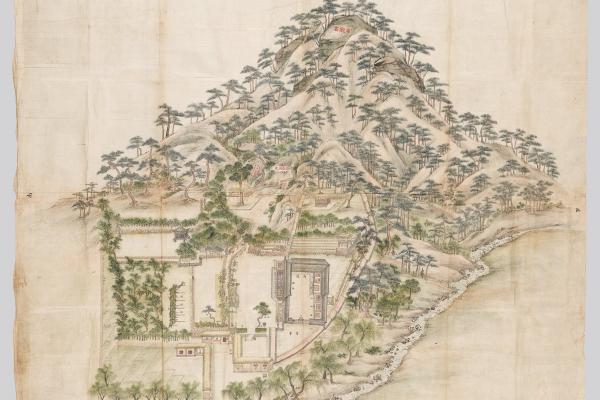
The Institute for Japanese Studies, the Institute for Korean Studies, and the Department of History of Art present:
Misato Ido
Assistant Professor
Kyoto Institute of Technology
&
Soojin Kim
Lecturer
Seoul National University
"Envisioning Screen Paintings in Korea and Japan"
Flyer:
Presentation by Misato Ido
"Discovering 'Oriental Painting': Adaptation and Reformation of Bird-and-Flower Paintings in 1890-1920"
Abstract: Bird-and-flower paintings are a commonly appreciated genre in East Asian art. Owing to their symbolism of the auspicious, in many cases they were commissioned for special occasions such as birthdays and childbirths. In Japan many gilded folding screens and sliding doors depicting pine trees with birds and flowers were produced in the sixteenth and seventeenth centuries. The main theme of this paper is to delineate the circulation and transformation of the style and iconography of the ‘bird-and-flower paintings’ in East Asia by shedding light on the convention of copying masterpieces.
Although the format of the folding screen and the subject matter of bird-and-flower originated in China, it is well known that gilded screen paintings of birds and flowers were highly evaluated as diplomatic gifts to China and Korea from Japan. It is necessary therefore to explore the influence of this genre of paintings, including its styles and motifs, within the East Asian context. The first part will examine how the bird-and-flower paintings were exchanged among China, Korea, and Japan as gift or whatever purposes. The second part will explore how the bird-and-flower paintings originated in China were circulated and transformed in Japan and Korea, specifically focusing on the style and technique of the Kano School as well as the newly emerged concept of sketch from life. I will also argue that the style and technique of Shen Quan (1682-1760) from the Zejiang province, China infused the new perspective of observing nature with sketch from life and therefore was widely accepted by authorities such as shoguns and daimyos who were enthusiastic about acquiring comprehensive and scientific pertain to herbalism and natural history in the mid-Edo period. Lastly, I would like to extend the discussion to include the early modern era when the style of Shen Quan was reevaluated in the context of Pan-Asianism by introducing the bird-and-flower paintings with the style of Shen Quan that were rendered by Japanese painters in colonial Korea.
Bio: IDO Misato received her PhD from the Interdisciplinary Cultural Studies Department, University of Tokyo (2011). Her doctoral dissertation investigated the visual representations and symbolic meanings of pre-modern Japanese genre paintings. As an assistant professor at the Kyoto Institute of Technology, she researches medieval Japanese art in multimedia and international contexts, paying particular attention to folding screens and the spaces within which they were appreciated. She is the recipient of a grant from the Japan Society for the Promotion of Science (2013–) and she conducts a project entitled “Ritual, Space, and the Folding Screen in East Asia.
Presentation by Soojin Kim
"Rivalry for Cultural Supremacy: Construction of Architectural Space and Its Representation in 19th century Joseon Society"
Abstract: In pre-modern Korea, the ownership of villas and the patronage for paintings of those villas were exclusive activities only for the privileged circles. Those estate paintings were not only ostentatious instruments but also strategical media to embody political messages and cultural supremacy. This talk begins with introductions of such patronage activities in the Joseon society, which involved two powerful families: Andong Kim clan, one of the most influential courtier families; Jeonju Lee clan, the Royal Family of the Joseon Dynasty. Since the seventeenth century, Andong Kim family had continued their constructions of villas within and without the capital city and maintained their patronage for paintings of those villas, depending on family’s political vicissitudes. By depicting the patron as a recluse, a guardian of the cultural heritage, or a power-holder, the family actively employed the function of paintings, which created political, social and cultural messages in the most elegant ways. From the mid-nineteenth century, however, not only Andong Kim’s ownership of villas but also their tradition of visual representations were taken over by the Royal Family, as Regent Heungsun began to take the measure to keep a tight rein on Andong Kim’s monopolization of political power. Ironically, the Royal Family had continued their confiscation activities of such cultural supremacy even though the Dynasty itself stepped into the downfall in the twentieth century.
Given this story, the talk will elucidate the socio-cultural meaning of the rivalry in art patronage by focusing on the history of two families. In so doing, I hope my talk could contribute to a more nuanced understanding of the nineteenth-century Joseon society that has been limited by an unbalanced focus on political history.
Bio: Dr. Soojin Kim is a lecturer at the Department of Archeology and Art History of Seoul National University. Her field of research is visual materials of the Joseon Dynasty and their functions and meanings. In her doctoral dissertation, “The Golden Age of Folding Screens: A Study of Screen Painting in Late Joseon Korea”, she sheds light on the history of Joseon’s folding screens and their role as effective media conveying “Neo-Confucianism” and “Rule of Ritual”, two ruling ideologies of the dynasty. She was a visiting fellow at Harvard-Yenching Institute, Korea Foundation intern at the Museum of Fine Arts, Boston, and a project researcher at Kyujangkak. Currently she is conducting research for her first monograph on Confucian rituals and paintings.
Free and open to the public
This event is made possible by the Institute for Japanese Studies, the Institute for Korean Studies, the Department of History of Art, and by a U.S. Department of Education Title VI grant to The Ohio State University East Asian Studies Center.
